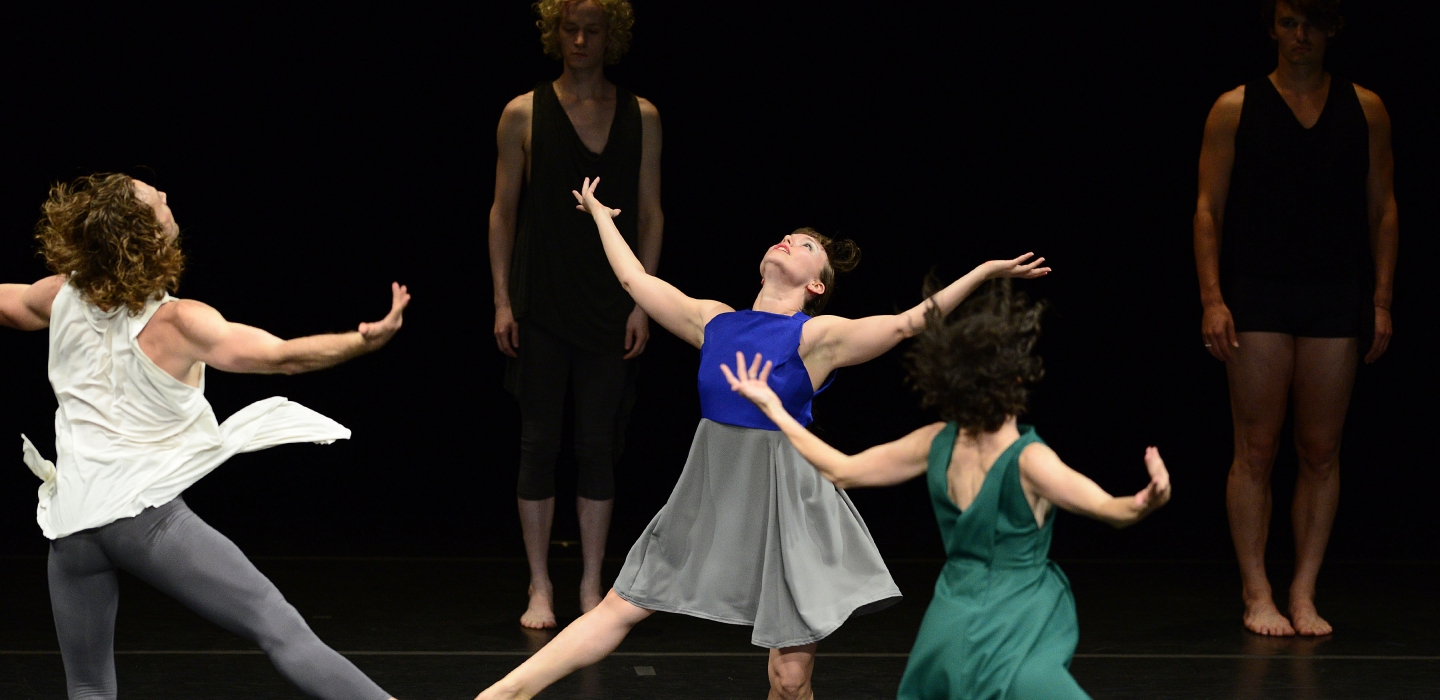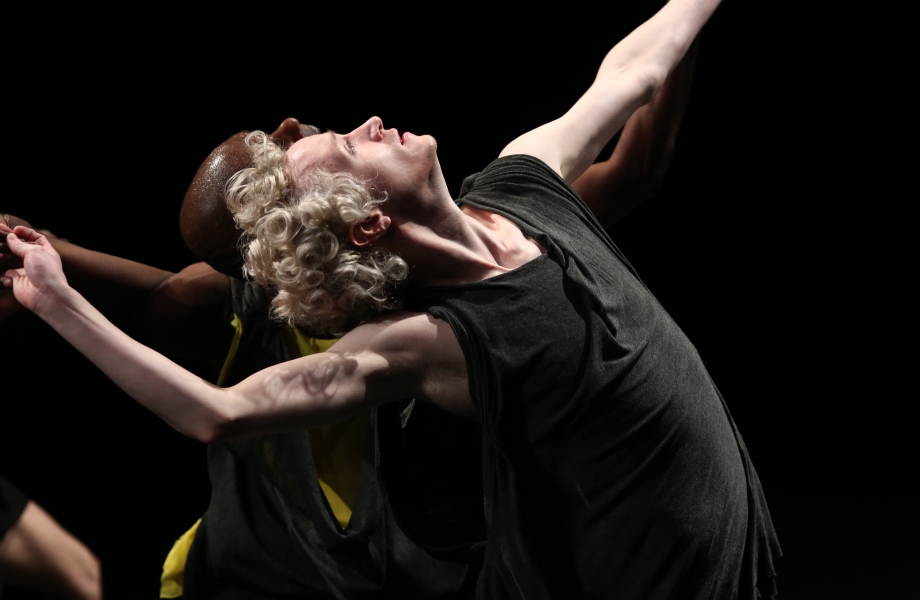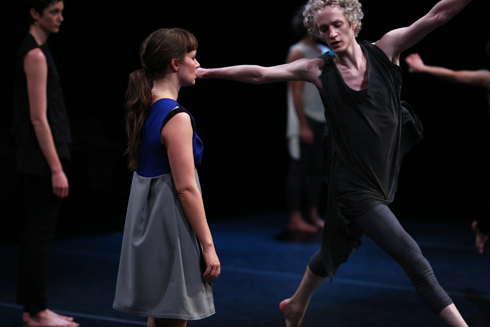BLEED and Becoming

Tere O’Connor’s work is a conjuring, a bringing in of everything and an invitation to unravel. At the level of composition, three earlier dances (Sisters, poem, and Secret Mary) provide alternate pasts for the larger work, memories for and behind and within the current motions. In terms of content, BLEED is comprised of tensions between: body, expectation, form, temporality, mood, action. As these oppositional nodes counterbalance, polarize, and heave within the bodies of the dancers, things bleed into other things—dancer becomes watcher, myth becomes sculpture, movement becomes image.
In a hypnotizing opening solo, Heather Olson sways and eats, stumbles and awakens for nearly five minutes, exposed in her alone-ness within the stage’s boundless universe. Meanwhile, the off-kilter rhythms of industry drone on. Through a stripping down of the elaborate ensemble sequences to come, Olson’s virtuosic movement establishes the epic, operatic scale upon which O’Connor is working. In a piece that meditates on sociality, she functions as an interpretive lure that at first inspires easy commentary. White women are so often used and discarded as seductive appeal, the decoy to get us to look twice, or the scapegoat at the end of the disaster. While Olson dances, I cycle through the old tropes: the rag doll, the drunk girl, this Freudian pantomime, A Doll’s House, and the slight vindication of the rights of woman.
The solo appears sculpted as blurred performativity—a re-enactment of white femininity grounded in theory, where gender identity constitutes an act of mimicry perpetuated across time through the “stylized repetition of acts.”1 Olson’s movements swing through the repetitive moments of everyday life and the dramatic motions our bodies make in experience. But these stylized variations don’t exactly produce gender. In fact, she looks to be performing aloneness. Soon enough, her aloneness conjures the group, calling other dancers to the stage. The dancer is happening. She is an act, opening.
In a theatrical turn at the end of her solo, Olson gasps, arm back to the side in a three-dimensional rendering of this familiar, even beloved cinematic moment. Why did she gasp? we gasp. Why aren’t we always gasping? The gasp indicates she is undone. In BLEED, the dancer is a body inscribing through the anti-narrative image-making of O’Connor’s choreography. In horror films, the white woman gasps, but who is the gasp for? How can she be surprised, over and over again, when woman is forever scripted as the victim and absorber of pain? The gasp fails; we see through it, even as we are brought into it as an event. Gay people love to gasp; we’ve incorporated it into our camp repertoire as a stylized repetition of undone-ness. It’s queer cleverness that O’Connor stages the gasp as opening event—the gasp with its endless variation, its everything semiotics, and attendant mess of politics as narrative trope, gay affect, misogynistic effect, and most simply that embodied pull of breath wherein one loses oneself.
In his choreography, O’Connor does meaning and undoes it, evoking the sign and refusing the signified in the same moment by inviting all connotation and perspective inside the gesture. This making is nearly the opposite of a speech act (the founding principle of Butler’s gender performativity, where “I do” enacts marriage). O’Connor’s choreography seems instead to look at action and gesture as existing within a vast pattern of relations.

Olson’s gasp calls in the ensemble. Like programmed automatons, they enter and do their work. Five times in a row she falls and they pick her up. The affective register confuses. Is the ensemble moving as a colony of social insects? Have their bodies combined into a single machine? Even as the pick up performs interdependency quite literally, this simple action alters the territory of the dance, introducing a central problem BLEED will explore: how can we push back against the myths of self-creation and individuality that cause harm?
As we witness re-membered things bleed into other things over the course of the performance, BLEED uses movement to propose alternatives to selfhood. O’Connor demonstrates a queer preoccupation with matter and its morphing, exploring modes of animacy—within the context perhaps of what Mel Y. Chen theorizes as the “capacity to rewrite conditions of intimacy, engendering different communalisms and revising biopolitical spheres”2—in outright rejection of the hierarchies that normally order everyday movement. A politicized and queer posthumanist aesthetic pops up in BLEED where movement does not only belong to the human or to the live: the flight of birds, iron filings within a magnetic field, the functional flow of cellular life. Bodies become together through movement.

This feeling that I’m watching through a microscope, or from farther away, is one of awe, a meditative perspective instilled in me by the bodies moving like other bodies and the shifts between micro- and macro- scale. From the direction of matter (breath in the body, the dimensions of the biological, the troubling of human individuality), BLEED is about theorizing the collective; as dance, it finds aesthetic beauty in natural and social forms of the collective. Collectives can form across many kinds of terrains, which themselves may inevitably disassemble and reassemble toward new potentials. In BLEED, bodies are unstable assemblages—what moves the dancers is the touch, energy, and contrast of encounter rather than an interiority or single thought. Within such queer encounters (where tidal wave becomes riotous protest, a queer kiss arrives in a microbial tableau, botanical arrangements dramatize the act of witnessing), O’Connor devotes all energy and force to resounding multiplicity, continual variation, and the radical refusal to be incorporated into stable systems of meaning. Now, in our present that we hold all around us and within, that system of meaning is the white supremacist settler capitalist cisheteropatriarchy nation-state. To imagine another way is to bleed, to gasp, to dance in the swirling-together that is the conjuring of selves, the conjuring of worlds.
- Judith Butler, Gender Trouble: Feminism and the Subversion of Identity, (New York: Routledge, 1990).
- Mel Y. Chen, Animacies: Biopolitics, Racial Mattering, and Queer Affect,(Durham, NC: Duke University Press, 2012).
